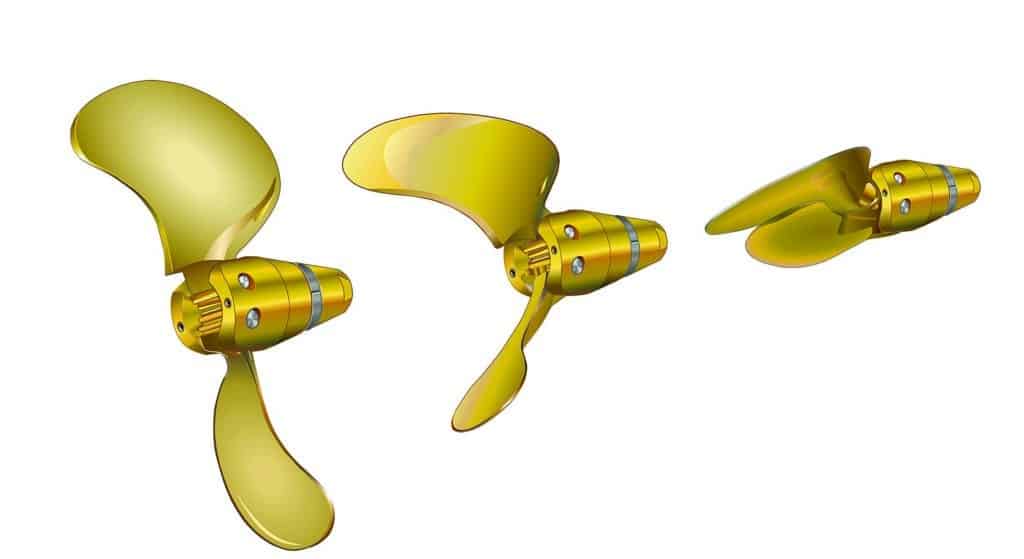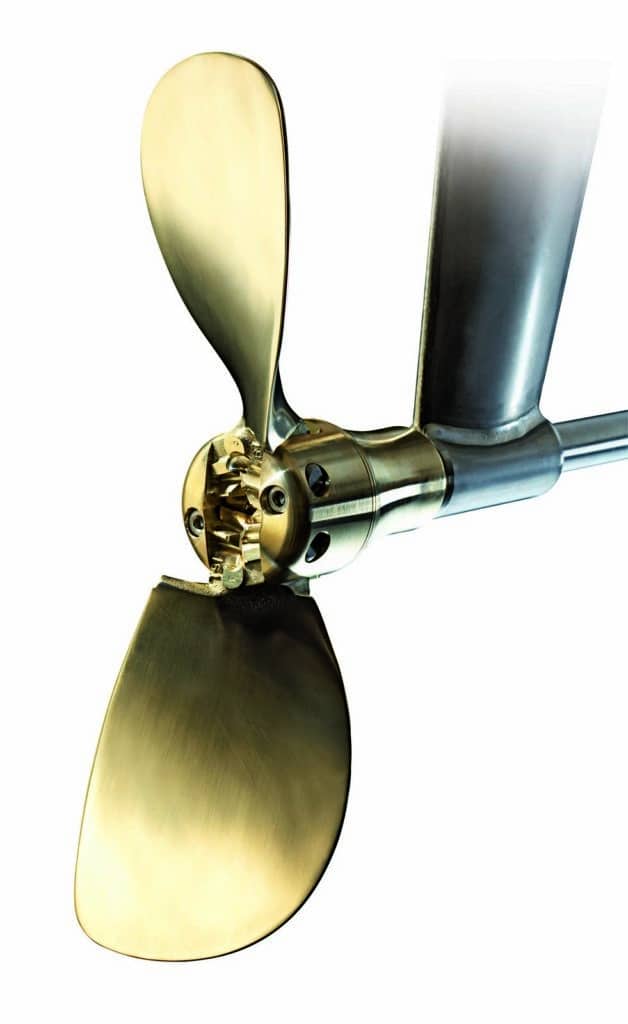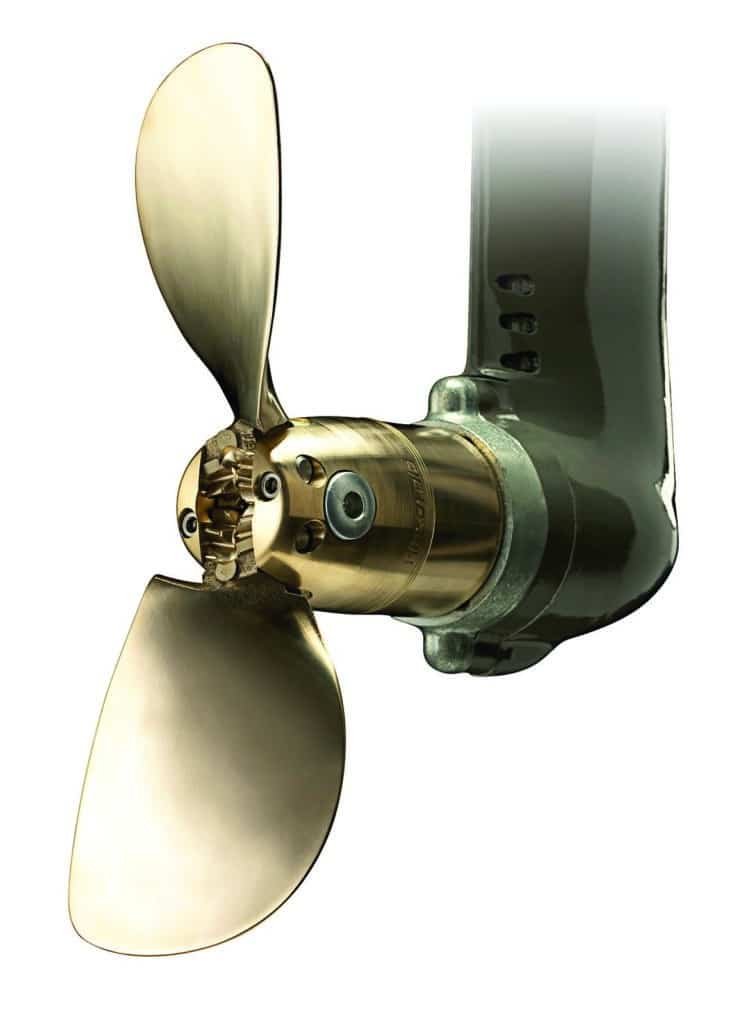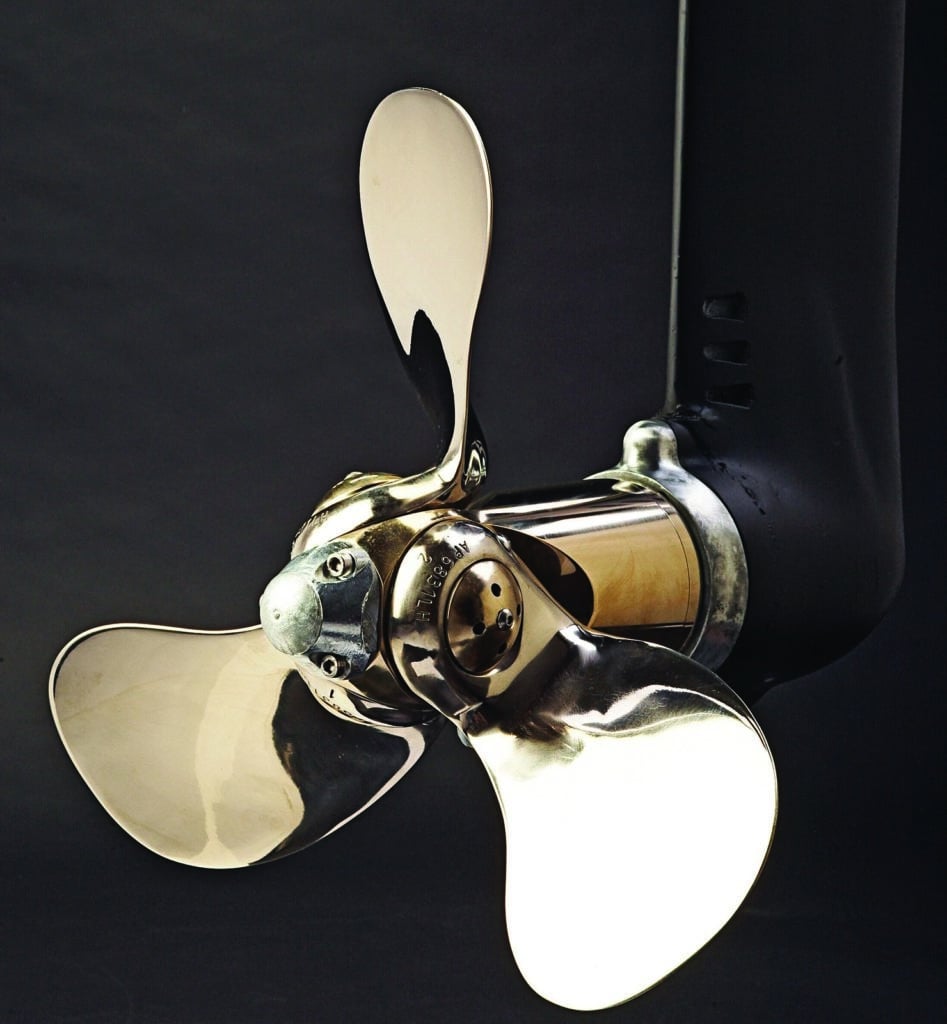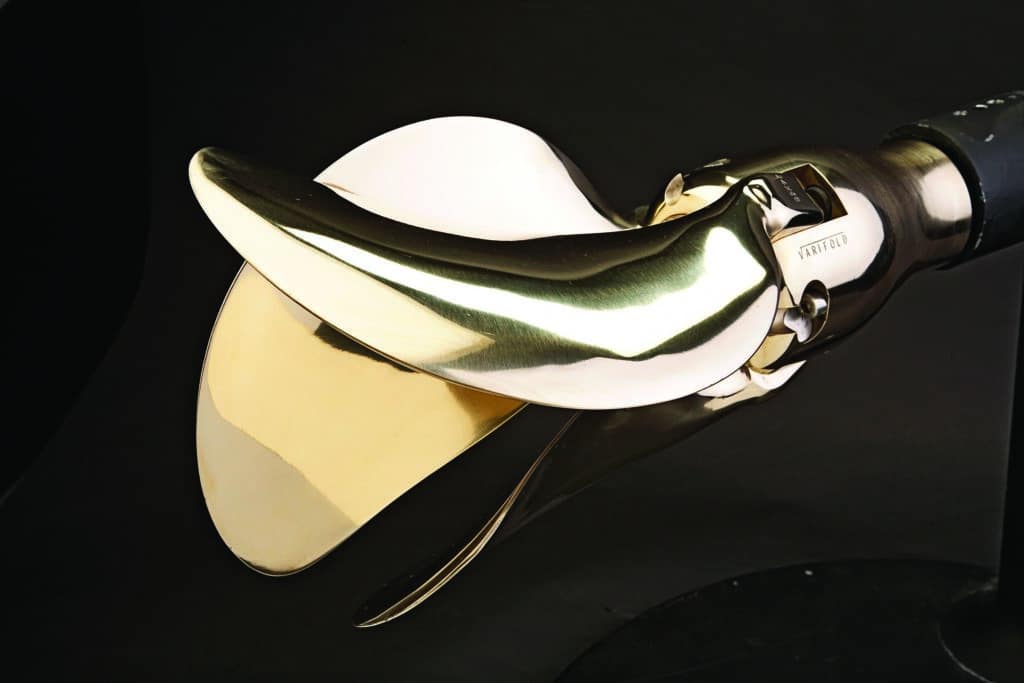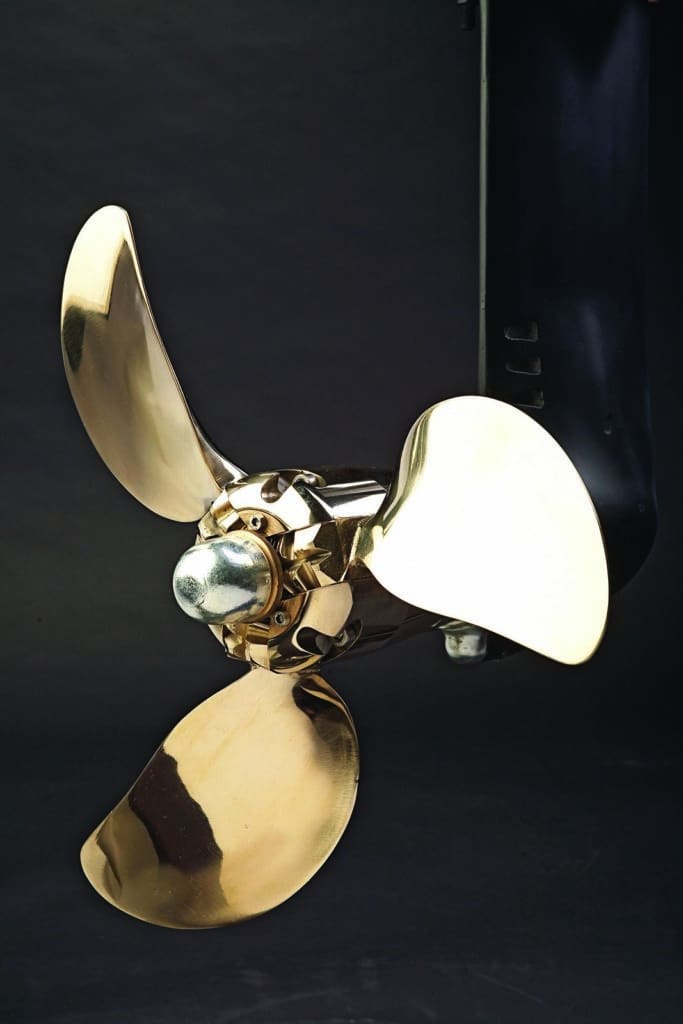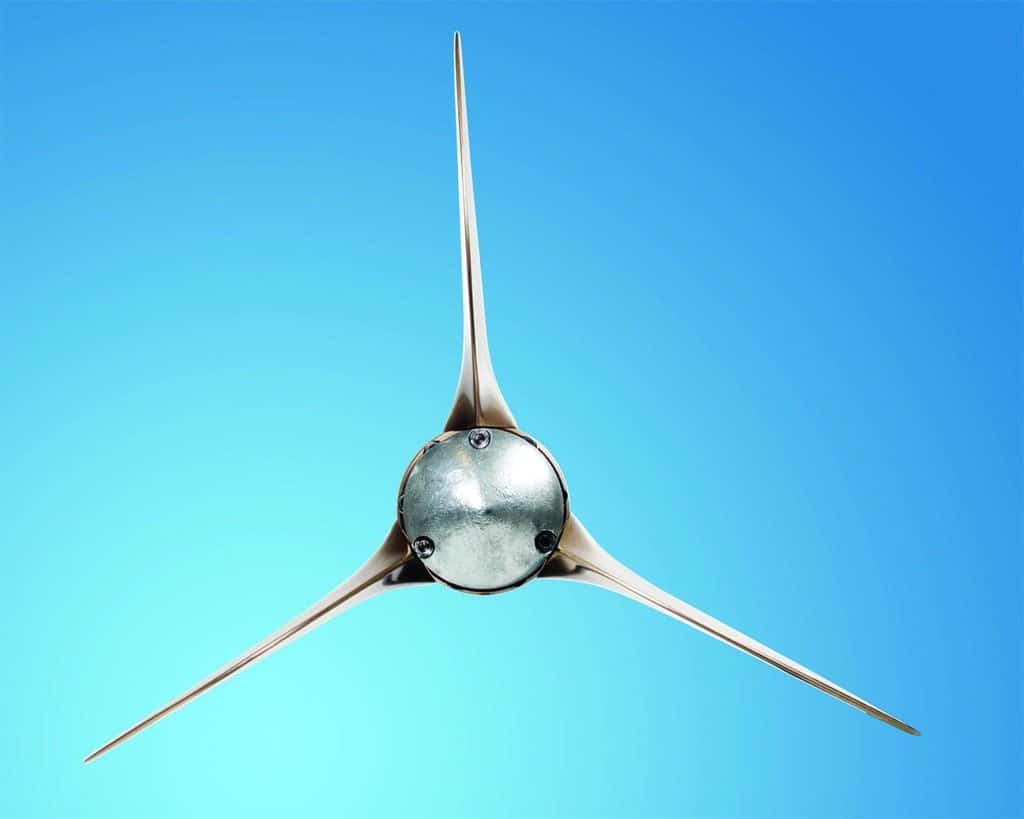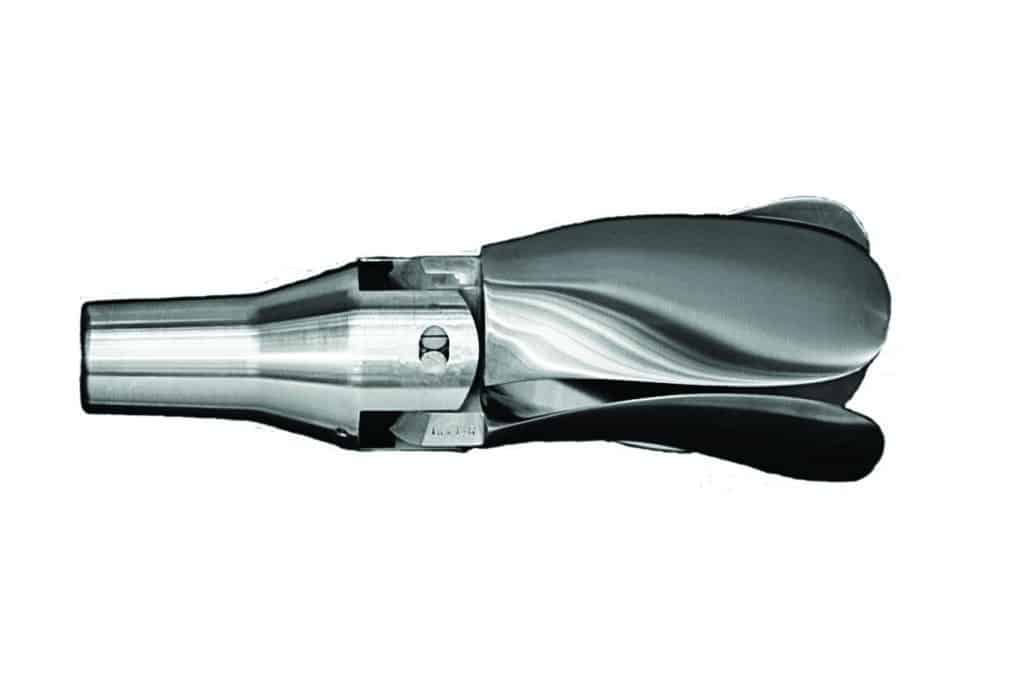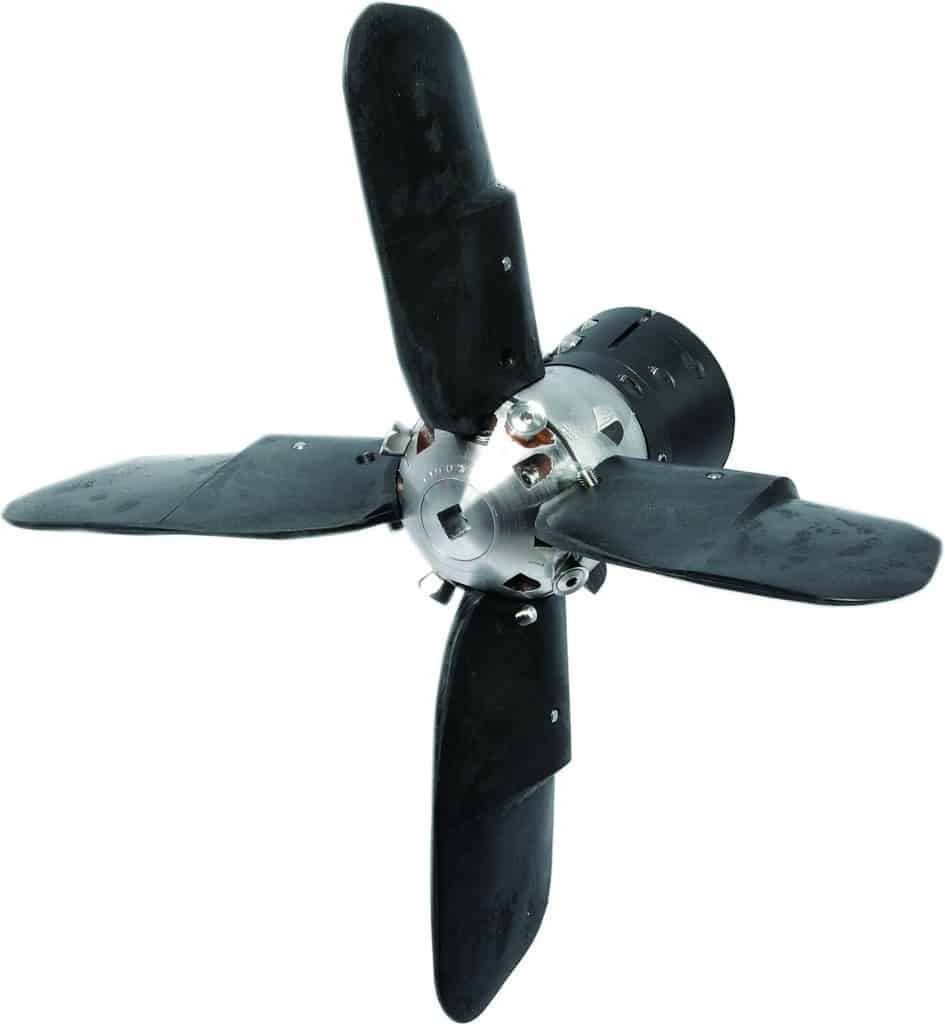Props 101
Out of sight and out of mind, sailboat propellers are often an afterthought for cruising sailors. Ironically, because manufacturers have developed a variety of efficient sailboat propellers designed to maximize thrust under power while minimizing drag under sail, selecting the right prop for a sailboat can be even more complex than it is for a power vessel. In order to make an informed decision and choose the right propeller for your needs, it’s important to understand the advantages and disadvantages of all the options available.
Propeller Geometry
Before delving into specific types of sailboat propellers, in order to grasp how all the design elements work together, it’s important to understand the basics of propeller geometry. All propellers — from sailboats to power cruisers, outboards to aircraft carriers — share the following characteristics.
To start, the hub is the central part of the propeller, to which its blades are attached either as a single casting or mechanically; it, in turn, is connected to the propeller shaft in traditional drive trains, or to the saildrive, which has become more and more prevalent in contemporary cruising boats. Regarding those blades, the leading edge is just that: the edge that leads into the water when turning ahead. (It’s also the edge closest to the forward part of the propeller hub.) The trailing edge, conversely, is the opposite edge of the blade (the one closest to you when standing on the aft side of the prop).
The root is the inboard side of the blade and forms the transition where the blade connects to the hub, while the tip is the outboard edge of the propeller blade. The blade face is also known as the pressure side, and is the side that faces aft. The blade back is also known as the suction side, and is the side that faces forward.
The majority of propellers are right-handed; viewed from astern, they rotate clockwise when moving forward, and have a slight tendency to swing the stern to starboard. Since the propeller is designed to be most efficient when going ahead (the direction one travels the vast majority of the time), this side force is minimal. When going astern, however, the opposite is true, and the stern will “walk” to port, which is usually the more pronounced of the two side forces and can therefore be a distinct advantage, or disadvantage, when maneuvering in close quarters. Prop walk is dependent on several factors, including hull shape, but also the propeller itself. An inefficient propeller will introduce more prop walk than an efficient one.
Diameter and pitch are two of the most basic dimensions used to describe a propeller. If you were to attach a pencil to the tip of one of the blades and rotate the propeller one full turn, tracing a circle, the distance across this circle would be the diameter of the propeller. Next, if you were to rotate the propeller one full revolution in a solid medium that does not slip (think of a screw in wood), the pitch would be the forward distance that the propeller would travel in that single revolution. With modestly sized yacht propellers, diameter and pitch are routinely measured in inches (as opposed to feet or meters for ship propellers). So a 12-by-20 prop has a 12-inch diameter and a 20-inch pitch.
Given the definition of pitch, you might wonder why you wouldn’t choose a propeller with higher pitch in order to gain additional power. But propellers must be sized in relation to the rest of the propulsion system, and must match the power curve of the engine, as well as the rpm range afforded by the reduction gear. As such, a propeller with excessive pitch may not actually generate additional thrust, since it would overload the engine and prevent it from reaching the designed rpm, which can reduce fuel efficiency and increase wear to critical engine components. Additionally, an overloaded propeller is susceptible to cavitation, which happens when a prop rotates and creates a partial vacuum. Water rushes in to fill that vacuum, creating tiny bubbles; when they collapse, they basically pound the prop. While cavitation will occur in small amounts in very localized areas on almost every propeller, excessive cavitation will result in a loss of thrust, excessive noise, and vibration, and can be violent enough to actually pit or erode the propeller.
Many blades also have rake and skew. Rake is the forward or aft slant of the blades when viewed from the side. Propellers are generally given some degree of aft rake to help increase efficiency while decreasing vibration. In fact, many propellers on outboard engines exhibit a significant amount of aft rake. A propeller blade is skewed if it is asymmetrical with respect to a straight radial line drawn outward from the hub. Skew helps reduce pressure fluctuation and therefore vibration and noise.
As an example, think of those classic World War II films, when the submariners would huddle together, waiting for the next depth-charge attack while listening to the pulsating sound of the destroyer’s propellers as it passed overhead. That distinct pulsation was caused by the difference in pressure as each propeller blade passed close to the ship’s hull. Even if the propeller blades were equidistant from the hull on all sides (think of a propeller in a tunnel or nozzle), the pressure difference between the propeller tip closest to the surface and the tip that is deepest can be substantial enough, especially in larger propellers, to cause similar pulsation. The prop on a modern submarine is an example of a highly skewed propeller; the sickle-shaped blades are designed to reduce noise and vibration to an absolute minimum, even at the expense of propulsive efficiency.
The number of blades can also play a significant role in the propeller’s performance. As with skew, at least in theory, a greater number of blades will generally reduce vibration, since for a given rpm there is less time between each blade passing a given fixed point. That said, if a propeller is well designed and dynamically balanced, a two-bladed prop will not vibrate more than a three- or four-bladed prop. However, in instances where a shaft is slightly out of alignment, a three-blade prop could help decrease shaft vibrations.
Along these lines, if a propeller had an infinite number of blades — if it were a solid disc — there would be no vibration. Additionally, a propeller with more blades will generally have a larger expanded area than one with fewer blades, although that is not necessarily always the case. Expanded area is essentially the total area of the blades. For a given horsepower, a larger expanded area will result in lower thrust loading, or conversely, a propeller with a larger expanded area can absorb more power prior to experiencing significant cavitation. At the end of the day, it’s a delicate balance between optimum blade area and the potential for excessive diameter. Wide diameter causes excessive tip speed, which results in cavitation.
Propeller Options
There are several propeller types available for auxiliary sailboat applications. To begin, let’s look at some basic but often confused definitions for different types of propellers.
Blades may have constant or variable pitch. A propeller with constant pitch has blades whose pitch, or angle of attack, remains the same from the root to the tip. Conversely, a variable-pitch propeller has blades that appear twisted; that is, the blades will have greater pitch at the root and less pitch at the tip.
While constant-pitch propellers are easier and therefore cheaper to manufacture, variable-pitch blades are more efficient. Consider each blade’s motion as the propeller spins. At a given rpm, the part of the blade near the root is moving much slower than the part near the tip. If this seems confusing, think about the change in circumference as we move outboard on each blade; a point closer to the hub has less distance to travel to complete a full circle than does the tip of the blade. Since they both must complete the revolution at the same time — they are, after all, two points on the same blade — the point near the tip must move faster than the point near the root. Now, we also know that the faster the blade moves, the more thrust it will produce. So, in order to maintain constant thrust along the entire blade, the pitch is reduced as we move farther out toward the tip.
Propellers may also have either fixed pitch or controllable pitch. Fixed props are available in a wide range of diameters and pitches. All fixed props have twisted blades, but as the name suggests, they can’t be adjusted. Feathering props, alternatively, have flat blades with no twist. This makes the blade area relatively inefficient, but that drawback is offset by the ability to adjust the blades’ pitch.
A controllable-pitch propeller also has the ability to change the pitch of the prop blades, by rotating each blade at the root, but these props are generally used on superyachts, not your normal cruising boat. On these larger vessels and ships, controllable-pitch propellers are used to keep the engine operating in the most efficient rpm band by varying the pitch of the propeller to change its thrust rather than the speed of the engine.
Additionally, many controllable-pitch propellers also have reversible pitch: In order to provide astern thrust, the pitch of the propeller blades is reversed while the propeller continues to spin in the same direction. For larger ships, this has some distinct advantages, as it eliminates the need to stop the propeller before turning it in the other direction. This simplifies the machinery required and dramatically reduces the time before reverse thrust is produced, therefore increasing maneuverability. For sailing vessels, in addition to the advantages previously described, controllable-pitch propellers can often “feather” the blades to minimize drag while sailing.
Controllable-pitch props can also be adjusted to maximize the power and efficiency of your particular propulsion system and boat, something that fixed-pitch propellers cannot do. This ability to fine-tune the propeller — coupled with advanced blade designs in controllable-pitch props — may promote a notable increase in power, speed and efficiency. It’s important to note, however, that compared to fixed-pitch models, these controllable-pitch benefits do come at increased cost. Cost aside, the complexity of the system also may make it more prone to issues than a fixed-pitch propeller, and more difficult to find parts and complete repairs when voyaging in remote regions.
Of course, many sailors are familiar with folding propellers, which are fixed-pitch models designed to fold back in order to minimize drag while under sail. Like fixed props, these come in a wide variety of diameters and pitches, have twisted blades, and aren’t adjustable. Originally, folding props were generally two-bladed, but three-bladed props are now widely used and very popular, and four-bladed models are also available. Folding props are designed so the centrifugal force of the spinning shaft will cause the blades to unfold when the engine is engaged. Folding propellers are less complicated than their controllable-pitch cousins, but compared to standard fixed props, they still offer reduced drag under sail. When folded, they are also less prone to being fouled by seaweed or other debris than a feathered, controllable-pitch propeller.
In days gone by, many folding propellers got bad raps for several reasons. They wouldn’t open immediately at low rpm, particularly in reverse, or they required a revved engine to provide the sufficient centrifugal force to open them. Conversely, at low speeds while under sail, the flow of water was sometimes insufficient to keep the blades folded, particularly if the prop blades were aligned top to bottom (where gravity could open the bottom blade) rather than side to side.
When we raced sailboats when I was younger, we used to dive down and put a rubber band around the folded prop once we got out to the racecourse. Or we’d make a mark on the propeller shaft with paint or a permanent marker when the boat was on the hard; we could then position the shaft so the blades were aligned side to side once we secured the engine. However, those issues have largely been eliminated with today’s modern, highly engineered folding props. These days, the blades in most folding props are geared and synchronized, and very efficient in all conditions, whether under sail or motoring. Their reliability is underscored by the fact that they’re now standard equipment on new boats from Beneteau, Dehler, Gunboat, Hanse, J-Boats, Jeanneau, Morris and many other manufacturers.
The variety of propellers available today provides a wide range of options for sailors to choose from. The advantages and disadvantages of each propeller type must be weighed against your sailing and motoring style. When investigating a new prop, shop wisely and ask lots of questions of the specific manufacturers; it’s important to get personalized recommendations for your boat and your plans. Understand the differences to ensure you find the best fit for your needs.
Propeller Resources:
The following is a list of propeller manufacturers and their websites.
- Autoprop Automatic Variable-Pitch Propellers
- Flexofold Folding Propellers
- Gori Folding Propellers
- J Prop Feathering Propellers
- Kiwiprop Feathering Propellers
- Max-Prop Feathering Propellers
- Martec, Autostream and Slipstream Folding and Feathering Propellers
- Variprop and Variprofile Feathering Propellers
- Volvo Penta Folding Propellers
A graduate of the U.S. Coast Guard Academy, where he raced inshore on the varsity sailing squad and offshore to Bermuda and Halifax, Lt. Cdr. Michael Cilenti is currently second-in-command of the Coast Guard cutter Waesche out of Alameda, California.
